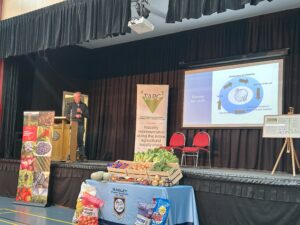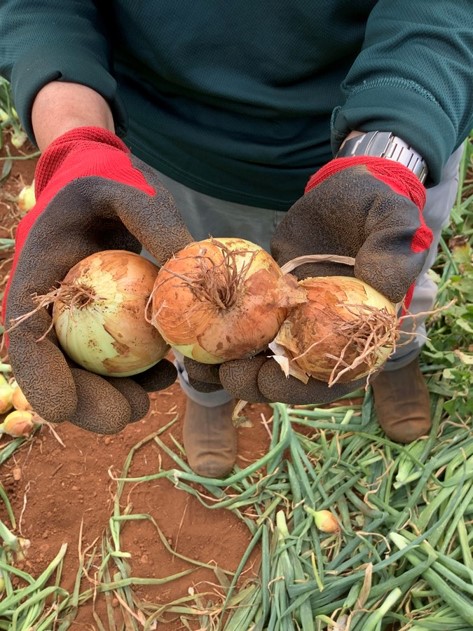Developing strategies to inhibit Onion White Rot
The project Optimising chemical and cultural control of onion white rot (VN20007) spanning five years, aims to develop an integrated disease management strategy for this soil borne disease caused by Sclerotium cepivorum.
The effects of onion white rot are far reaching with reduced yield in the field and the potential for disease spread in storage.
Onion white rot is a fungal disease that affects yields in commercial onion crops and it is prevalent throughout Tasmania but is also found in other onion growing regions. To date Western Australia is free from the disease. The fungi can remain dormant for as long as 20 years in the soil, but spreads quickly in the presence of Allium crops.
Onion white rot thrives in cool, moist soils with soil temperatures in the range of 7oC-22oC, with research showing that above 25oC, the disease is substantially inhibited. This suggests that planting later in the season in warmer conditions will limit the effects of the disease, but the drawback is missed early plantings and harvest.
Typical symptoms of onion white rot are brown to black rot predominantly on the roots near the soil. As the disease takes hold, a fluffy white fungal growth will appear at the base of the stem. Small poppy-seed size sclerotia will also be present on the bulbs. The disease can spread quickly, particularly through free-flowing water, with as little as one sclerotium per 10 kilograms enough to set the fungi spread in motion.
Recommendations for onion growers are to be vigilant around farm hygiene – minimising soil movement through personnel and equipment. Soil that is free draining so that it does not retain water will be of assistance as well as choosing varieties that have a strong root growth to assist with disease resistance.
During this project a soil DNA testing protocol is being developed to establish sampling procedures and pathogen thresholds. Further testing of the DNA test compared to field trials will determine the best method of soil sampling, as white rot can be sporadic throughout the paddock.
At a recent presentation at the Tasmania Ag Innovation Day, researcher Phillip Frost of Arvensis Research, said that white rot can be difficult to manage and can lie dormant until the next onion planting.
“Thankfully, white rot only affects allium crops particularly onion and garlic and is not hosted by other vegetables or weeds,” he said.

“It is spread through physical movement in the soil, unlike botrytis and downy mildew which can be airborne.
“It has a pretty simple lifecycle – the sclerotes stay in the soil until the onion crop is planted, which triggers germination. From there mycelium fungal filaments develop and spread through the soil. It has no sexual reproduction, it is more like a clone, so there is low genetic variability, making it easier to manage.”
It is known that germination of the schlerotes can be triggered by sulphide compounds released by the Allium root system. As a means of reducing disease pressure in the soil of onion white rot, the use of onion juice from waste onions or garlic extract may be useful. With the presence of the Allium compound as a germination stimulant, onion white rot will soon die away without the ongoing presence of an Allium plant. Further trials will determine application rates and timings with field trials commencing in the next growing season.
During field trials sampling for soil DNA tests showed the presence of pink root – it is unknown whether there is an interaction between the two pathogens. In the later stages of pink root, when the roots turn brown, it is difficult to visually distinguish between the two and the diseases often co-exist on onion roots.
Two new fungicides have recently been registered in onions for management of onion white rot, Luna Experience (Fluopyram, group 7 + Tebuconazole, group 3) and Intuity (Mandestrobin, group 11) which will offer growers two new fungicide groups (group 7 and 11) for management of onion white rot.
Trials conducted as part of this project have demonstrated both Intuity and Luna Experience provide effective control of onion white rot. Trials in the current season are focusing on optimising the placement and timing of fungicides to maximise their effectiveness.
“In terms of cultural management, later plantings definitely help but for the grower that puts a lot of pressure on harvest if it is wet. We estimate that 80 per cent of the cropping areas of Tasmania have white rot present so the risk is that growers push into more marginal soils creating pressures on quality and yield.
“In the next planting season, we will continue to compare soil samples in the field with lab tests to verify the DNA tests and the sampling methods. The use of a germination stimulant still has merit so we will continue to investigate a system for timing and application.
“With two new fungicides available, it will be about maintaining an optimum amount in the soil to hold the mycelium filaments at bay to protect the onion roots. It’s not about eliminating the white rot pathogen but inhibiting it.”
This project has been funded by Hort Innovation, using the onion research and development levy and contributions from the Australian Government. Hort Innovation is the grower-owned, not-for-profit research and development corporation for Australian horticulture.
This article first appeared in Australian Grower Winter 2024 magazine

